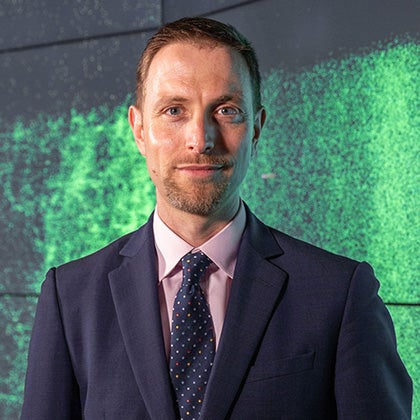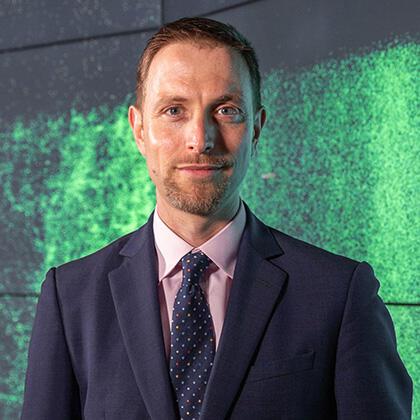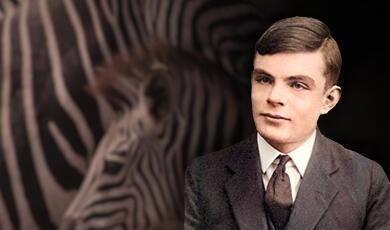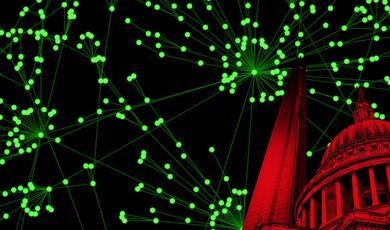Why Society Needs Astronomy and Cosmology
Share
- Details
- Text
- Audio
- Downloads
- Extra Reading
'One day, Sir, you may tax it': Faraday's prescient quip when quizzed about the practical value of electricity in 1850 neatly demonstrates that advanced societies cannot afford to stifle scientific curiosity for its own sake - a powerful if serendipitous driver of technological and societal progress.
It will be argued that fundamental research into astronomy, cosmology and particle physics is a luxury that humankind cannot do without. This cultural, technological and scientific returns of such an enterprise far outweigh the costs.
Download Text
15 March 2016
Why Society Needs Astronomy and Cosmology
Dr Roberto Trotta
"One day, Sir, you may tax it!"
In 1850 the Chancellor of the Exchequer, William Gladstone, reportedly visited Michael Faraday's laboratory at the Royal Institution of Great Britain. Faraday's reputation as one of the greatest scientists of his time was fully established: thanks to his experimental ingenuity and scientific mind, Faraday had made several ground-breaking discoveries in chemistry and physics, many of which would form the basis of virtually all modern technology.
Faraday discovered the principle of electromagnetic induction (that a moving magnet generates an electric current, and, vice-versa, a time-changing current produces a force on a magnet), which underpins electric motors and electric generators; he discovered diamagnetism (an effect that can be used to levitate objects in a magnetic field with no power consumption); and he championed the dialogue of scientists with the public, presenting a series of Christmas Lectures at the Royal Institution whose tradition continues to this day.
But in 1850 Faraday's work with electricity and magnetism looked a little more than a curiosity to most of his contemporaries – and certainly to politicians who could not begin to foresee the revolutionary implications of his discoveries. To the Chancellor's questions about the practical use of electricity, Faraday reportedly replied: "One day, Sir, you may tax it!"
Faraday's legacy
We do pay tax on electricity today – none of Faraday's fault, to be sure, but a testament to the ubiquitous nature of the technology that sprung out of his research into the fundamental laws of nature. The next time that we pay with a 20 pounds note (for those of us who live in the UK), we might want to look more closely at the flip side to the one bearing the Queen's portrait. A bemused Faraday peeks out, and while delivering one of the Christmas Lectures he appears to be reminding us of where it all came from: curiosity-driven research and Faraday's thirst for understanding what appeared to be quirk, unexplainable phenomena.
While an extraordinarily accomplished experimentalist, Faraday had little formal education and didn't have a great mastery of maths. It would befall James Clerk Maxwell to put Faraday's findings in a mathematical form that could be understood from first principles. This led to the four celebrated Maxwell Equations, published in the early 1860s, which to this day describe and govern all electric and magnetic phenomena.
The development of technology that would soon enter every household proceeded at an appropriately lightning pace: in 1876, Alexander Graham Bell transmits the first message via telephone; in 1880, Edison patents the incandescent light bulb; in 1888 Heinrich Rudolf Hertz demonstrates that radio waves can be transmitted through the air, paving the way for the wireless telegraph patented by Marconi in 1896. The first BBC broadcast from London would follow on Nov 14th, 1922. In 1904, the German inventor Christian Hülsmeyer patents a device he called "telemobiloscope". His invention didn't take hold at the time, but would become of great importance during World War II, when both Germany and the Allies made quick strides towards building a fully functioning radar.
In the post-war period, the technology that electricity enabled mushroomed everywhere, changing every aspect of life and defining modernity: in the house (think about electrical and motor-powered kitchen appliances); in the air (airplanes relying on radar and radio telecommunication); throughout society (the rapid diffusion of TV after the war, and the impact it had in terms of mass media and culture) and all the way to the Moon, with the space programme being inconceivable without electricity (Jules Vernes notwithstanding!).
Little new left to discover?
At the end of the 20th century, the prevailing view seemed to be that little new was left for scientists to discover: Lord Kelvin famously quipped, around 1900, that 'There is nothing new to be discovered in physics now. All that remains is more and more precise measurement.'
And how wrong he was! Very soon, what had appeared to be minor discrepancies in the solid edifice of physics turned out to be deep cracks that would send the entire building tumbling down.
The puzzling fact that the speed of light did not seem to change with respect to the relative velocity of the observer and the source (as proved by Michelson and Morley in 1887) was a nagging problem of the "aether theory". This theory postulated the existence of a medium through which light (i.e., electromagnetic waves) could propagate, for otherwise it was inexplicable how light could travel through empty space. But the failure to detect any change in the speed of light through the year (when the "aether" wind should change from June to December due to the motion of the Earth around the Sun) led to a crisis.
That crisis was resolved in 1905, when Einstein formulated the Special Theory of Relativity. His revolutionary step was to stipulate that the speed of light is constant with respect to any observer. This simple postulate had far-reaching consequences: for example, time and space become intertwined and different observers measure time and length to be different according to their relative state of motion.
At the same time, a major revolution was underway in our understanding of the microscopic world. Once again, it was ushered in by the stubborn resolution of some scientists to grasp the deep causes of what seemed to be fairly minor glitches in the behavior of some physical systems. Such phenomena could not be understood with the physics of the time.
Why, for example, were charged particles called electrons emitted by a metal only in discrete bursts of energy when a beam of light was shone on it, and not in a continuous stream (the photoelectric effect, for whose explanation Einstein was awarded his only Nobel Prize in 1921)? Or what was the distribution of energy emitted of a body at a certain temperature (a problem solved by Max Planck in 1900)? These fairly exotic phenomena led physicists to the idea that energy is not a continuously distributed quantity, but rather it comes in discrete packets, called "quanta". It was the dawn of a radically new theory of the microscopic world: quantum mechanics, about which Niels Bohr, one of its founding fathers, had to say: "Anyone who is not shocked by quantum theory has not understood it."
Apart from giving us a very detailed description and understanding of the sub-atomic world, quantum mechanics is at the heart of countless applications: from atomic clocks to nuclear power (and, sadly, nuclear weapons), from lasers to medical scanners, from semiconductors in computers and consumers electronics to quantum computers in the near future, today's technology is inconceivable without it.
Knowledge from the heavens
The study of the heavens is perhaps the most striking example of research done first and foremost to satisfy our thirst of knowledge. It is at first sight hard to conceive of sciences more far removed from everyday life and its concerns than astronomy and cosmology.
After all, most of the physical phenomena of the cosmos are separated from us by almost unimaginably vast distances. They happen over either very long times (the life of stars spans some 5 billion years) or in catastrophically short-lived, high energetic events (the merging of two black holes in a fraction of a second, emitting gravitational waves like the ones recently recorded by the LIGO instruments). The Universe is everything but at the human scale: too big, too old, too distant, to be of any practical use to us.
Or is it?
A closer look reveals that astronomy and cosmology have –many times- changed the way we understand our world: from Galileo discovering the four largest moons of Jupiter (1610), to Hubble establishing that the Universe is expanding (1929), and the discovery of the relic radiation from the Big Bang itself by Penzias and Wilson (1964), observations of the cosmos have led to radical shifts in our place in the Universe and our significance in it.
Big Science
Today, the study of the Universe is very different than it was even in the 1960s, when Penzias and Wilson literally stumbled on the left-over heat from the Big Bang when experimenting with a microwave receiver as a way of establishing an early form of satellite telecommunication. The myth of the lonely astronomer spending long, cold nights at his telescope (yes – unfortunately, part of the myth remains today that scientists and in particular astronomers are always male, something that countless talented female colleagues are working hard to dispel) is deeply engrained in popular culture.
But those days are largely over.
This is not to say that so-called "amateur" astronomers (who are often better observers than the pros!) cannot make important contributions to the field today. In fact, the advent of relatively affordable CCD technology and the digitalization of observational astronomy mean that the cosmos is more than ever within reach of an ever-increasing number of members of the public. The study of transient phenomena such as supernova explosions has greatly benefitted from a dedicated community of non-professional astronomers. Also, citizen-science projects like GalaxyZoo or SETI@Home, now give everybody a chance to step in and contribute to cutting-edge research from the comfort of their armchair. All that is needed is a computer and an Internet connection.
However, by and large astronomy and cosmology are moving in the direction of becoming more and more Big Science (and hence, big money) projects. This is because the technological advance of the 90's meant a rapid increase in the quantity of the data that we are able to gather about the cosmos.
To give but one of many possible examples: in 1982, the first CfA galaxy redshift survey measured the position of about 1,100 galaxies in the local Universe. At the time, this state-of-the-art survey used photographic plates to detect and measure galaxies in the sky. But with the advent of CCD cameras, the game changed rapidly: completed in 2002, the 2dF galaxy redshift survey obtained images and spectra of 250,000 galaxies, revealing the large-scale structure of the Universe. The Sloan Digital Sky survey increased the number of galaxies to 1.5 million over ten years.
As we move towards the future, the data throughput can only go one way: up. The Square Kilometer Array radio telescope, once completed in the mid-2020s, will measure over a billion galaxies. The Large Synoptic Survey Telescope will photograph the entire available sky with multiple filters every few days, starting in 2022, looking for asteroids, supernovae explosions, and mapping out the distant Universe in the search for dark matter and dark energy. Every year the amount of data produced will fill the hard-drive of 1000 average computers – impossible for humans to sift through, and requiring automated means of analysis, search for interesting objects, and scientific discovery.
In order to conceive, design, build and operate such complex instruments, astronomers are organizing themselves in ever-larger collaborations. Costs required (wo) manpower and timescales are even larger for space-based observatories. Such missions take decades from conception to delivery, involving hundreds or thousands of scientists, technicians and engineers.
Most research in astronomy and cosmology is funded through taxpayers' money – either through one (or several) of the big space agencies (NASA in the USA, ESA in Europe, Jaxa in Japan, and the UK Space Agency) or international consortia (e.g. the European Southern Observatory, ESO). The public at large rightly interrogate themselves about the rationale for what can sometimes be perceived as a cavalier use of public money. Especially at times of austerity and considerable belt-tightening, why should governments be spending billions on scrutinizing the farthest reaches of the cosmos?
Some might question the wisdom of spending all this money and effort on such projects. It is tempting to take the intellectual shortcut of thinking that those resources would be better spent on, for example, providing many of the citizens living in poverty in developing countries with better access to water, food and sanitation.
But, in the long run, this would be a false economy. The case for investing in fundamental research and in particular in the sciences of the cosmos is compelling. It is compelling on many fronts: societal, economical, cultural, and technological. Let us examine them in turn.
Inspiration
Astronomy and cosmology are hugely inspirational. I have been fortunate to meet thousands of people (and young people) over the last decade, and engaged them at public lectures, science and literary festivals, events and workshops. In schools, museum, churches and sports halls. From France to Mexico, from San Francisco to Edinburgh, from Cape Town to Switzerland, everywhere people of all levels of education and all backgrounds come together to hear about the latest discoveries (and outstanding mysteries) about the cosmos.
There is something primordial in our connection to the stars, and modern science offers a way to answer some of the most fundamental questions of existence: When did the Universe begin (13.8 billion years ago), how big is the cosmos (infinite, as far as we can tell), what will its destiny be (it will continue expanding forever, at an ever accelerating speed).
But it is in young people that the magnetic fascination for the cosmos can make wonders. 80% of undergraduate physics students cite interest in the Universe as one of the reasons that led them to choose this subject for their degree. Not every physics undergraduate will become a professional scientist – indeed, not even 10% of astronomy PhD's stay in academia long-term. But that does not matter: the inspiration and enthusiasm for science that studying the cosmos provides can last for a lifetime. It helps nurturing interest and passion for technology and fundamental science in a new generation. In today's world, those are the key ingredient for long-term success and economic growth.
Economy and Technology
The economic case for investing in the study of the Universe is very strong. It is important to dispel the perception that astronomy is prohibitively expensive, even given the scale of today's instruments and collaborations.
The Planck space observatory is a recent European Space Agency mission that mapped out in great detail the temperature of the relic radiation emerging from the Big Bang itself. Launched in 2009, the spacecraft first travelled to the so-called second Lagrange point, a special spot 1.5 million km from the Earth, outside the orbit of the Moon, where the gravitational attraction of the Earth and Sun are such that a stable orbit is possible with almost no fuel consumption. Over the course of 15 months, the spacecraft observed the leftover light from the Big Bang, emitted when the Universe was only 380,000 years old, and meticulously measured tiny temperature differences. Encoded in this measurements was a cosmic fingerprint telling us about the age of the Universe, how it came to be in the first 10-32 seconds after the Big Bang, and that most of its contents are dark energy and dark matter.
The price tag for the mission was somewhere in the region of 1 billion euros, with about 600 million for the launch alone. Ground-based telescopes are usually much cheaper: the Sloan Digital Sky Survey cost about 85M USD for the entire 15 years of its operations, and it produced over 5800 scientific papers, many with ground-breaking discoveries. At less than 15,000 USD per paper (the cost of a cheap car), this is really good value for money!
More seriously, even big space missions with a billion dollar price tag are cheap when put in context: about the price of a coffee per year per European citizen. When compared with overall government spending, the cost of astronomy is equivalent to the pennies found between the sofa seats. At the height of astronomy spending in 2010 (before austerity started to bite), the UK government was investing 0.05% of its budget in astronomy-related research. This would have been sufficient to fund the NHS for about a day – or to buy four F35 military jets.
But of course money spent on astronomy and cosmology does not just disappear: it actually comes back into the economy, multiplied several times over. There is evidence that every pound spent on astronomy generates 10 pounds worth of societal impact. This takes the form of training and education, but also innovation and societal benefits, often taking unsuspected forms. For example, data analysis techniques developed by astronomers to manipulate, decipher and analyze Big Data in astronomy are being applied in financial modeling and trading. The extreme data processing requirements of current and future telescopes is driving technology to create new forms of data storage and parallel computation. Imaging techniques invented to interpret and sharpen astronomical images are improving cancer diagnostic techniques. The examples are countless.
Culture
But cosmos is also culture. By this I mean that there should be no difference between the immediate recognition that the name of Shakespeare brings (even for those who have not necessarily read any of his work) and that of any of the great astronomers that have done so much to change our vision of the cosmos. That this is sadly not the case shows that C.P. Snow's argument about the need to bridge the gap between the "two cultures" (science vs humanities) still needs to be made.
But ultimately I consider the fundamental reason for studying the Universe to be quite simple: as a society, we do it because it is challenging; because it broadens our horizons beyond the finite limit of our lifespans (both as individuals and as a species); because, just like the arts, it helps us make sense of who we are; because it makes the world a better place by uniting in the pursue of a common goal large numbers of men and women worldwide, who work together across cultural, religious and racial boundaries in a spirit of collaboration towards improving human knowledge.
In 1969, the first director of the US particle physics laboratory FermiLab was summoned by Congress, to a hearing to establish whether the large sum of money required to build FermiLab was justified. Senator Pastore, questioning Wilson, opened with:
"Here we are, asking for $250 million [about 1.6 billion USD today] to build a machine that is an experimental machine, in fundamental high energy physics, and we cannot be told exactly what we are trying to find out through that machine."
Wilson explained what the machine was trying to achieve, and specified that it had no connection with the military. He was asked whether the accelerator could help beating the Russian in any way, or help defend the United States – to which he replied:
"[…] This new knowledge […] has nothing to do directly with defending our country except to help make it worth defending."
Speaking to hearts, not just minds
The power of enthusiasm and passion for science is often undervalued in our society, which tends to reward more tangible and measurable outcomes. This is perhaps a consequence of a way of communicating science that, all too often, focuses on people's minds, and forgets to speak to their heart.
As a professional astrophysicist, I am fortunate to be able to devote my working life to some of the deepest and most intriguing questions ever: What is the fundamental nature of the cosmos? What are dark matter and dark energy made of? What is the destiny of the Universe? The answers to those questions might not change our lives in the immediate future -- but they will revolutionise our understanding of our place in the cosmos, and with it the meaning of our being here.
In my first book for the public, "The Edge of the Sky" (Basic Books), I took an approach that, in its economy, tries to unlock the power of simplicity, to generate a new kind of dialogue with the public at large about astronomy and cosmology. Believing that often less is more, I endeavoured to describe the entire Universe (the "All-There-Is") using only the most common 1,000 words in the English language.
So a spacecraft bound to Mars becomes in the simple, straight-forward language of my book a "space-car flying to the red Crazy-Star, named after the Fight-God, where it will look for little life"; a telescope is a "Big-Seer"; scientists are "Student-People"; our galaxy is "the White Road", and other galaxies become "Star Crowds".
The book tells the story of a Student-Woman who spends a night observing far-away Star Crowds with the help of Big-Seer, looking for dark matter:
She steps outside in the cold night, holding her cup of hot coffee with both hands. The White Road is beautiful in the dark, clear sky, and, once again, she cannot help but be amazed by it all.
It does not matter how many times she has seen this before, or how much she knows about what is out there. The sight of the stars is enough to make her gasp. "It all seems so still and yet it's changing all the time," she whispers to no one. It is hard to believe that everything out there past the White Road and its stars is running away from us.
Yet, like Mr. Hubble found long ago, the Star-Crowds are running away from each other, as the space between them gets bigger and bigger. The All-There-Is is growing with time.
From sunset to sunrise, we follow her as she reflects about our Home-World and the other Crazy Stars around the Sun, and the many more that go around far-away stars; the way the All-There-Is grows, and how it began in a Big Flash; and all the questions we still have on it, like dark matter, the Dark Push and the existence of other kinds of All-There-Is.
It is my hope that my book might help enthuse a younger generation for the power of science - and the way science can change the way we see the All-There-Is.
Finally, a word of advice: Should anybody come across the Chancellor tonight, please don't tell him about dark matter, and how it's five times more abundant than normal matter. Given that dark matter will probably be discovered within the next 5 to 10 years, I fear that following in the footsteps of his predecessor, the Chancellor might have the idea of taxing it!
© Dr Roberto Trotta, 2016
This event was on Tue, 15 Mar 2016
Support Gresham
Gresham College has offered an outstanding education to the public free of charge for over 400 years. Today, Gresham College plays an important role in fostering a love of learning and a greater understanding of ourselves and the world around us. Your donation will help to widen our reach and to broaden our audience, allowing more people to benefit from a high-quality education from some of the brightest minds.


 Login
Login







